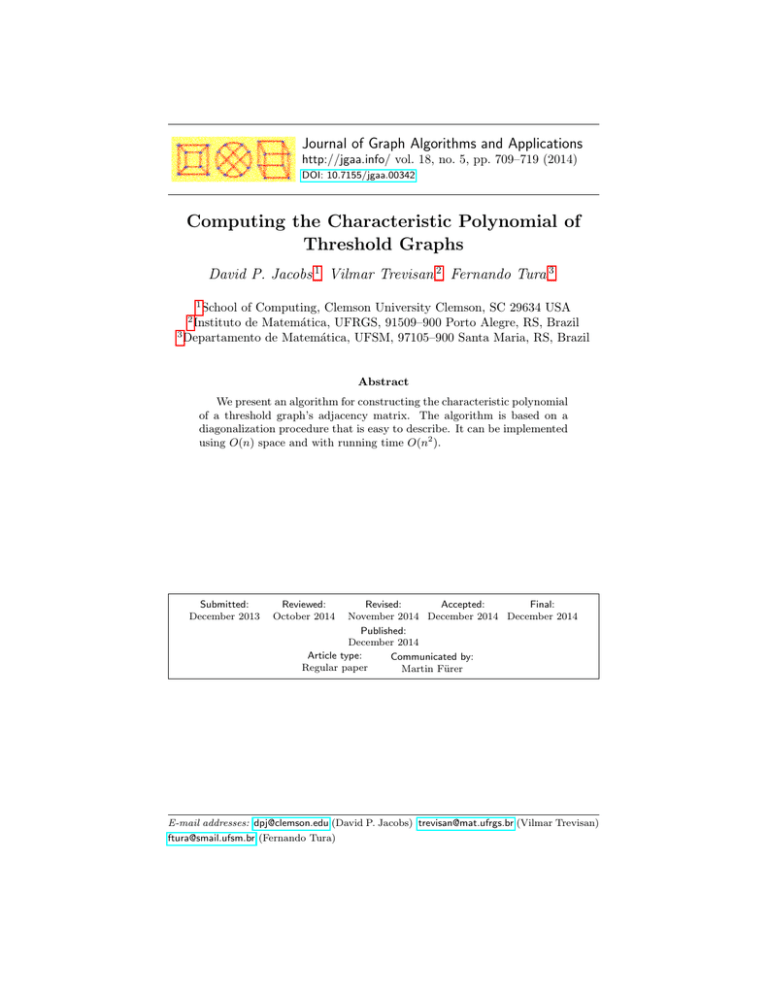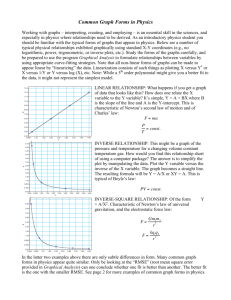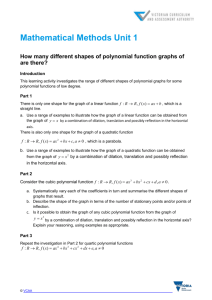Computing the Characteristic Polynomial of Threshold Graphs David P. Jacobs
advertisement

Journal of Graph Algorithms and Applications
http://jgaa.info/ vol. 18, no. 5, pp. 709–719 (2014)
DOI: 10.7155/jgaa.00342
Computing the Characteristic Polynomial of
Threshold Graphs
David P. Jacobs 1 Vilmar Trevisan 2 Fernando Tura 3
1
School of Computing, Clemson University Clemson, SC 29634 USA
Instituto de Matemática, UFRGS, 91509–900 Porto Alegre, RS, Brazil
3
Departamento de Matemática, UFSM, 97105–900 Santa Maria, RS, Brazil
2
Abstract
We present an algorithm for constructing the characteristic polynomial
of a threshold graph’s adjacency matrix. The algorithm is based on a
diagonalization procedure that is easy to describe. It can be implemented
using O(n) space and with running time O(n2 ).
Submitted:
December 2013
Reviewed:
October 2014
Revised:
Accepted:
Final:
November 2014 December 2014 December 2014
Published:
December 2014
Article type:
Communicated by:
Regular paper
Martin Fürer
E-mail addresses: dpj@clemson.edu (David P. Jacobs) trevisan@mat.ufrgs.br (Vilmar Trevisan)
ftura@smail.ufsm.br (Fernando Tura)
710
1
D. Jacobs,V. Trevisan, F. Tura Threshold Graphs
Introduction
Given G = (V, E), an undirected graph with vertices V = (v1 , . . . , vn ) and edge
set E, its adjacency matrix A(G) = [aij ] is the n×n 0–1 matrix for which aij = 1
if and only if vi is adjacent to vj (that is, there is an edge between vi and vj ).
Let x be an indeterminate. The characteristic polynomial of G is usually defined
as ρG (x) = det(xIn − A). Some authors define it as det(A − xIn ), however these
polynomials differ by the factor (−1)n . Their roots are called the eigenvalues
of G.
This paper is concerned with threshold graphs, introduced by Chvátal and
Hammer [3] and Henderson and Zalcstein [5] in 1977. They are an important
class of graphs because of their numerous applications in diverse areas which
include computer science and psychology [10]. Threshold graphs can be characterized in several ways. One way of obtaining a threshold graph is through an
iterative process which starts with an isolated vertex, and where, at each step,
either a new isolated vertex is added, or a dominating vertex is added. We may
represent a threshold graph G on n vertices using a binary sequence (b1 , . . . , bn ).
Here bi = 0 if vertex vi was added as an isolated vertex, and bi = 1 if vi was
added as a dominating vertex. This representation has been called a creation
sequence. In our representation b1 is always zero. If n ≥ 2, G is connected if
and only if bn = 1. In constructing an adjacency matrix, we order the vertices
in the same way they are given in their creation sequence. Figure 1 shows the
adjacency matrix of the threshold graph represented by (0, 1, 0, 1, 1).
0
1
0
1
1
1
0
0
1
1
0
0
0
1
1
1
1
1
0
1
1
1
1
1
0
Figure 1: Adjacency matrix of threshold graph.
In [12] Sciriha and Farrugia discussed combinatorial and spectral properties
of threshold graphs. Threshold graphs were studied in [1, 13, 14] under the
name nested split graphs. In [8] the authors identified those threshold graphs
having the smallest eigenvalue among all threshold graphs of order n, and in [9]
showed that no threshold graph has an eigenvalue in the real interal (−1, 0).
Algorithms and formulas for the characteristic polynomial of trees have been
studied in [7, 6, 11] and by M. Fürer, who in [4], presented an O(n log2 n)
algorithm for computing the characteristic polynomial of a tree on n vertices.
The good performance for tree algorithms is somewhat expected since the
matrices associated are sparse. For general graphs there is no known algorithm
for computing its characteristic polynomial that performs better than algorithms
for general matrices, which can be obtained in O(n3 ) [15].
Since adjacency matrices of threshold graphs can be dense, obtaining an
efficient algorithm is a greater challenge. In this paper, taking advantage of
JGAA, 18(5) 709–719 (2014)
711
the structure of the adjacency matrix, we present efficient algorithms for constructing the characteristic polynomial ρG (x) where G is a threshold graph. We
can assume that G is connected for otherwise ρG (x) = xk ρG0 (x), where G0 is a
connected component.
Our characteristic polynomial algorithm is based on the diagonalization algorithm for threshold graphs presented in [8], and these ideas are reviewed in
Section 2. In Section 3 we present an algorithm for constructing the characteristic polynomial of a threshold graph that runs in time O(n2 log n) and
space O(n). We illustrate our algorithm in Section 4. In Section 5 we discuss
a method used in [12], based on equitable partitions, for computing the characteristic polynomial of threshold graphs. Finally, in Section 6, we sketch an
interpolation approach that has time O(n2 ) and space O(n).
2
Diagonalization
Recall that two matrices R and S are congruent if there exists a nonsingular
matrix P such that R = P T SP . An important tool used in [8] was an algorithm
for constructing a diagonal matrix D congruent to Bx = A + xI, where A is
the adjacency matrix of a threshold graph, and x is an arbitrary scalar. Our
algorithm only adds scalar multiples of a row (column) to another row (column),
i.e. performs elementary type III operations, and so det(P ) = 1. The algorithm
is shown in Figure 2. The diagonal elements are stored in the array d, and the
graph’s initial representation is stored in b.
Algorithm Diagonalize works bottom up. For a graph of order n, it makes
n − 1 steps. Each diagonal element, except the first and last, participates in
two iterations. During each iteration, the assignment to dm produces a final
diagonal element. On the last iteration, when m = 2, the assignment to dm−1
also produces a final diagonal element at the top.
Note when bm = 0, the algorithm does nothing and moves to the next step.
Also note that the values in b can change. In each iteration, the algorithm
executes one of the five subcases. It should be noted that subcase 1a and
subcase 2b are the normal cases, and the other three subcases represent singularities. Executing subcase 1b requires x = 1, executing subcase 2a requires
x = 0, and executing subcase 1c requires α + x = 2. The following theorem,
whose proof appears in [8], asserts the correctness of the algorithm.
Theorem 1 For inputs G and x, where G is a threshold graph with adjacency
matrix A, algorithm Diagonalize computes a diagonal matrix D, which is congruent to A + xI.
3
Symbolic algorithm
The characteristic polynomial is obtained by computing det(xIn − A), where x
is an indeterminate. This can be done by diagonalizing A − xIn , multiplying
the diagonal elements, and then adjusting the sign. Algorithm Diagonalize
712
D. Jacobs,V. Trevisan, F. Tura Threshold Graphs
Algorithm Diagonalize(G, x)
initialize di ← x, for all i
for m = n to 2
α ← dm
if bm−1 = 1 and bm = 1
if α + x 6= 2
αx−1
dm−1 ← α+x−2
dm ← α + x − 2
else if x = 1
dm−1 ← 1
dm ← 0
else
dm−1 ← 1
dm ← −(1 − x)2
bm−1 ← 0
else if bm−1 = 0 and bm = 1
if x = 0
dm−1 ← 1
dm ← −1
else
dm−1 ← α − x1
dm ← x
bm−1 ← 1
end loop
//subcase 1a
//subcase 1b
//subcase 1c
//subcase 2a
//subcase 2b
Figure 2: Diagonalizing A(G) + xI.
will diagonalize A + xI over any field F , where x ∈ F . Thus we may use
Diagonalize(G, −x) to compute det(A − xIn ). However we are no longer working over R, but rather the quotient field R(x) of R[x]. Over this field, the
algorithm can be simplified.
Lemma 1 During the execution of Diagonalize(G, −x), it is impossible for
the algorithm to enter subcase 1b or subcase 2a.
Proof: Since x is an indeterminate, x 6= 0, 1.
During the execution of Diagonalize(G, −x) there is a sequence of n elements of R(x), calculated right to left
αn−1 (x), . . . , α1 (x), α0 (x) = −x
that are temporarily assigned to the diagonal. We call it the α-sequence. Except
for the final value αn−1 , each gets overwritten. When the algorithm executes
subcase 1a, we have:
αi+1 (x) =
−xαi (x) − 1
αi (x) − x − 2
(1)
JGAA, 18(5) 709–719 (2014)
713
When the algorithm executes subcase 2b,
αi+1 (x) = αi (x) +
1
x
(2)
Lemma 2 Assume Diagonalize(G, −x) executes only subcase 1a and subcase 2b for its first j steps. Then for each i ≤ j, αi (x) = p(x)
q(x) , where p(x)
and q(x) are polynomials such that
1. deg(p) = deg(q) + 1;
2. p(x) has a negative leading coefficient;
3. q(x) has a positive leading coefficient.
Proof: By induction on i. When i = 0, we have α0 (x) = −x
1 . So assume αi
having
these
three
properties,
and
consider
αi+1 . There
can be written as p(x)
q(x)
are two cases, according to whether subcase 1a or subcase 2b occured in
the last iteration.
subcase 1a Then (1) holds, and we have
αi+1 (x) =
−x p(x)
q(x) − 1
p(x)
q(x)
−x−2
=
xp(x) + q(x)
xq(x) − p(x) + 2q(x)
Using the induction assumption, we see that the degree and leading coefficient properties are preserved.
subcase 2b Then (2) holds, and we have αi+1 (x) = αi (x) + x1 = xp(x)+q(x)
.
xq(x)
Using the induction assumption, we see that the degree and leading coefficient properties are also preserved.
This completes the proof.
Lemma 3 During the execution of Diagonalize(G, −x), it is impossible for
the algorithm to enter subcase 1c.
Proof: Suppose, by contradiction, the algorithm enters subcase 1c. Then it
must be the case, that for some i, αi (x) = 2 + x. Assume this is the first such
i. By Lemma 2
p(x)
lim αi (x) = lim
= −∞.
x→∞
x→∞ q(x)
But
lim 2 + x = ∞.
x→∞
This is a contradiction.
It follows from Lemma 1 and Lemma 3 that Diagonalize(G, −x) can only
execute subcase 1a or subcase 2b. The simplified algorithm is shown in
Figure 3, and there is no modification of the bi required. After diagonalization,
the determinant is computed by multiplying the diagonal terms and adjusting
the sign. We have:
714
D. Jacobs,V. Trevisan, F. Tura Threshold Graphs
Algorithm CharPoly(G)
initialize di ← −x, for all i
for m = n to 2
α(x) ← dm
if bm−1 = 1
x·α(x)+1
dm−1 ← − α(x)−x−2
dm ← α(x) − x − 2
else if bm−1 = 0
dm−1 ← α(x) + x1
dm ← −x
end if
end loop
Qn
ρ(x) = (−1)n i=1 di
Figure 3: Characteristic Polynomial of Threshold Graph G.
Theorem 2 Algorithm CharPoly computes the characteristic polynomial of a
threshold graph G.
Algorithm CharPoly makes O(n) polynomial arithmetic operations. As the
proof of Lemma 2 shows, those operations inside the loop are simple and each
can be done in linear time. The final product involves multiplying n rational functions. Using fast polynomial arithmetic, each multiplication will take
O(n log n), so the running time is O(n2 log n). By constructing the partial product inside the loop, only O(n) space is required.
4
Examples
Example 1 We apply Algorithm CharPoly to the threshold graph represented
by (0, 0, 1, 1). After initialization, there will be three steps. Since b3 = 1 and
α(x) = −x, in the first step the assignments
d3
←
d4
←
x(−x) + 1
−2x − 2
−2x − 2.
−
are made. Since b2 = 0 and α(x) = − x(−x)+1
−2x−2 , in the second step we have:
d2
←
d3
←
x(−x) + 1 1
+
−2x − 2
x
−x.
−
1
Since b1 = 0, and α(x) = − x(−x)+1
−2x−2 + x , in the final step we have:
d1
←
d2
←
1
x(−x) + 1 1
+ +
−2x − 2
x x
−x.
−
JGAA, 18(5) 709–719 (2014)
The following table shows the steps of algorithm
bi
di
bi
bi
di
0
−x
0
0 −x
0
−x
0
−x
0
1
−x
1
− x(−x)+1
−2x−2
1
1 −x
initial
1
di
−x
− x(−x)+1
−2x−2 +
bi
0
715
di
− x(−x)+1
−2x−2
+
2
x
1
x
0
−x
−x
1
−x
−2x − 2
1
−2x − 2
1
−2x − 2
step 1
step 2
step 3
2
The characteristic polynomial is (− x(−x)+1
−2x−2 + x )(−x)(−x)(−2x − 2) or
x4 − 5x2 − 4x.
Example 2 We implemented our algorithm in Maple, and computed the characteristic polynomial of the threshold graph of order 16 having creation sequence
(0, 1, 0, 1, 0, 1, 0, 1, 0, 1, 0, 1, 0, 1, 0, 1), depicted in Figure 4. In the figure, the vertices v1 , . . . , v16 are arranged counterclockwise with v1 at the top. The algorithm
quickly computed
x16 − 64 x14 − 280 x13 − 252 x12 + 784 x11 + 1708 x10 + 156 x9 − 1930 x8
−832 x7 + 992 x6 + 408 x5 − 336 x4 − 40 x3 + 62 x2 − 14 x + 1.
Figure 4: Threshold graph (0, 1, 0, 1, 0, 1, 0, 1, 0, 1, 0, 1, 0, 1, 0, 1)
716
5
D. Jacobs,V. Trevisan, F. Tura Threshold Graphs
Equitable partition approach
We mention that there is an alternate approach for computing the characteristic
polynomial of a threshold graph G, that uses a reduction procedure, and takes
into account the multiplicity of the eigenvalues 0 and −1. We refer the reader
to [2, 9, 12, 13, 14] for details, and summarize the results important to our
discussion. Let G be a threshold graph with creation sequence
b = (b1 , b2 , . . . , bn ) = 0s1 1t1 . . . 0sk 1tk ,
where b1 = 0 and bn = 1. Then
1. the multiplicity of 0 is the number of substrings 00 in b.
2. the multiplicity of −1 is given by:
(P
k
i=1 (ti − 1)
Pk
1 + i=1 (ti − 1)
if s1 > 1
if s1 = 1.
After removing the terms x and (x + 1), we construct an equitable partition
matrix whose characteristic polynomial is the remaining factor.
Figure 5: Threshold graph (0, 1, 1, 1, 1, 1, 0, 0, 0, 0, 0, 0, 1, 1, 1, 1)
As an example, consider the threshold graph G of order 16 represented by
(0, 1, 1, 1, 1, 1, 0, 0, 0, 0, 0, 0, 1, 1, 1, 1) = 015 06 14 and depicted in Figure 5, where
the blue cells represent cliques and the white cell represents the independent
set. Using the formulas above, we see that the multiplicity of zero is 5, and the
multiplicity of −1 is 8. We form the equitable partition matrix
3 6 6
4 5 0 .
4 0 0
Computing the characteristic polynomial of this smaller matrix, we see that the
characteristic polynomial of G is
x5 (x + 1)8 (x3 − 8x2 − 33x + 120).
This method is useful when the size of the equitable partition matrix is
relatively small, that is, when the graph has high multiplicities of 0 and −1.
JGAA, 18(5) 709–719 (2014)
717
However, in this case, because the equitable partition matrix does not have a
special structure, general tools must be used to find its characteristic polynomial.
This reduction does not seem useful for graphs having low multiplicity of 0 and
−1. For example, in the graph of Figure 4 the reduction would produce an
equitable partition matrix that was 15 × 15.
The method described in this paper is an efficient algorithm that can compute the characteristic polynomial of any threshold graph.
6
Interpolation algorithm
It is theoretically possible to compute the characteristic polynomial in time
O(n2 ). We sketch the approach. On input G, we generate n + 1 arbitrary
distinct values xj ∈ R, j = 0, . . . , n. For each Q
xj , we call Diagonalize(G, xj )
n
to obtain a diagonal d. Computing yj = (−1)n i=1 di gives a point (xj , yj ) on
the graph. We then apply interpolation to the points {(x0 , y0 ), . . . , (xn , yn )}. It
is easy to see that each pair (xi , yi ) takes O(n) to construct and so it will take
O(n2 ) to generate the set. Finally, it is well-known that interpolation can be
done in time O(n2 ) and space O(n).
Acknowledgements
This work is supported by Science without Borders, under CNPq grant 400122/
2014-6. Vilmar Trevisan is partially supported by CNPq (Proc. 305583/2012-3
and 481551/2012-3) and by CAPES grant PROBRAL 408/13. Fernando Tura
acknowledges the support of CAPES Grant 0283/12-6.
718
D. Jacobs,V. Trevisan, F. Tura Threshold Graphs
References
[1] M. Andelić, C. M. da Fonseca, S. K. Simić, and D. V. Tošić. Some further
bounds for the Q-index of nested split graphs. J. Math. Sci., 182(2):193–
199, 2012. Translated from Sovrem. Mat. Prilozh., Vol. 71, 2011. doi:
10.1007/s10958-012-0739-x.
[2] R. B. Bapat. On the adjacency matrix of a threshold graph. Linear Algebra
Appl., 439(10):3008–3015, 2013. doi:10.1016/j.laa.2013.08.007.
[3] V. Chvátal and P. L. Hammer. Aggregation of inequalities in integer programming. In Studies in integer programming (Proc. Workshop, Bonn,
1975), pages 145–162. Ann. of Discrete Math., Vol. 1.
[4] M. Fürer. Efficient computation of the characteristic polynomial of a
tree and related tasks. Algorithmica, 68(3):626–642, 2014. doi:10.1007/
s00453-012-9688-5.
[5] P. B. Henderson and Y. Zalcstein. A graph-theoretic characterization of the
PVchunk class of synchronizing primitives. SIAM J. Comput., 6(1):88–108,
1977. doi:10.1137/0206008.
[6] D. P. Jacobs, C. M. S. Machado, and V. Trevisan. An O(n2 ) algorithm
for the characteristic polynomial of a tree. J. Combin. Math. Combin.
Comput., 54:213–221, 2005.
[7] D. P. Jacobs and V. Trevisan. Constructing the characteristic polynomial of
a tree’s adjacency matrix. In Proceedings of the Twenty-ninth Southeastern
International Conference on Combinatorics, Graph Theory and Computing
(Boca Raton, 1998), volume 134, pages 139–145, 1998.
[8] D. P. Jacobs, V. Trevisan, and F. Tura. Eigenvalue location in threshold
graphs. Linear Algebra Appl., 439(10):2762–2773, 2013. doi:10.1016/j.
laa.2013.07.030.
[9] D. P. Jacobs, V. Trevisan, and F. Tura. Eigenvalues and energy in threshold
graphs. Linear Algebra Appl., 465:412–425, 2015. doi:10.1016/j.laa.
2014.09.043.
[10] N. V. R. Mahadev and U. N. Peled. Threshold graphs and related topics,
volume 56 of Annals of Discrete Mathematics. North-Holland Publishing
Co., Amsterdam, 1995.
[11] M. Robbiano and V. Trevisan. Applications of recurrence relations for
the characteristic polynomials of Bethe trees. Comput. Math. Appl.,
59(9):3039–3044, 2010. doi:10.1016/j.camwa.2010.02.023.
[12] I. Sciriha and S. Farrugia. On the spectrum of threshold graphs. ISRN
Discrete Mathematics, 2011. doi:10.5402/2011/108509.
JGAA, 18(5) 709–719 (2014)
719
[13] S. K. Simić, F. Belardo, E. M. Li Marzi, and D. V. Tošić. Connected
graphs of fixed order and size with maximal index: some spectral bounds.
Linear Algebra Appl., 432(9):2361–2372, 2010. doi:10.1016/j.laa.2009.
06.043.
[14] Z. Stanić. On nested split graphs whose second largest eigenvalue is less
than 1. Linear Algebra Appl., 430(8-9):2200–2211, 2009. doi:10.1016/j.
laa.2008.11.026.
[15] J. H. Wilkinson. The algebraic eigenvalue problem. Monographs on Numerical Analysis. The Clarendon Press, Oxford University Press, New York,
1988. Oxford Science Publications.






